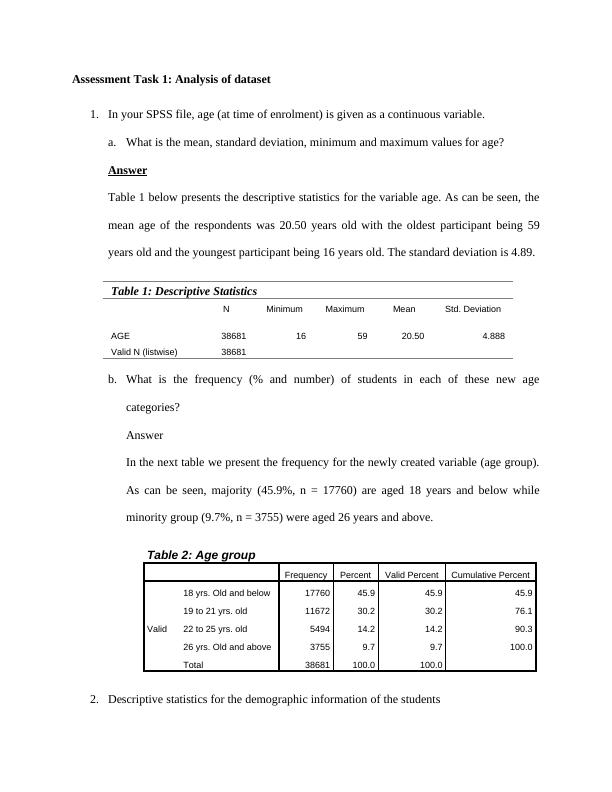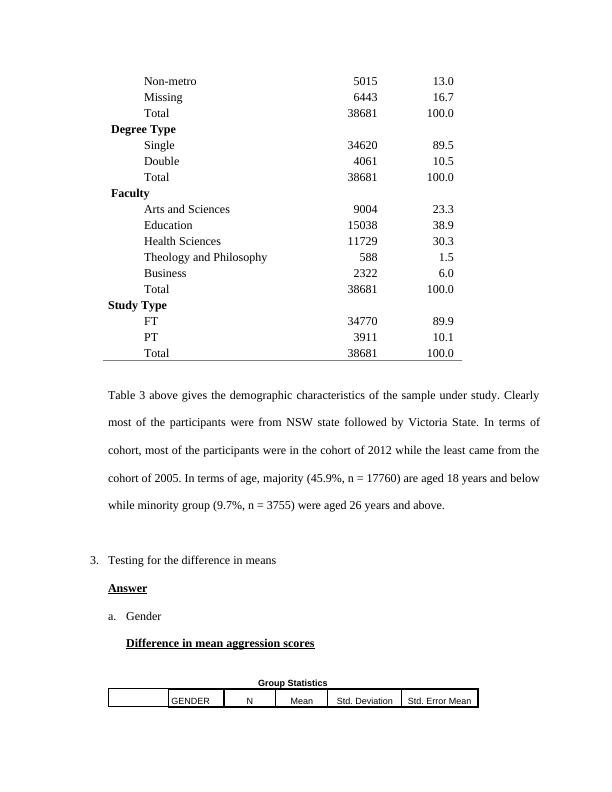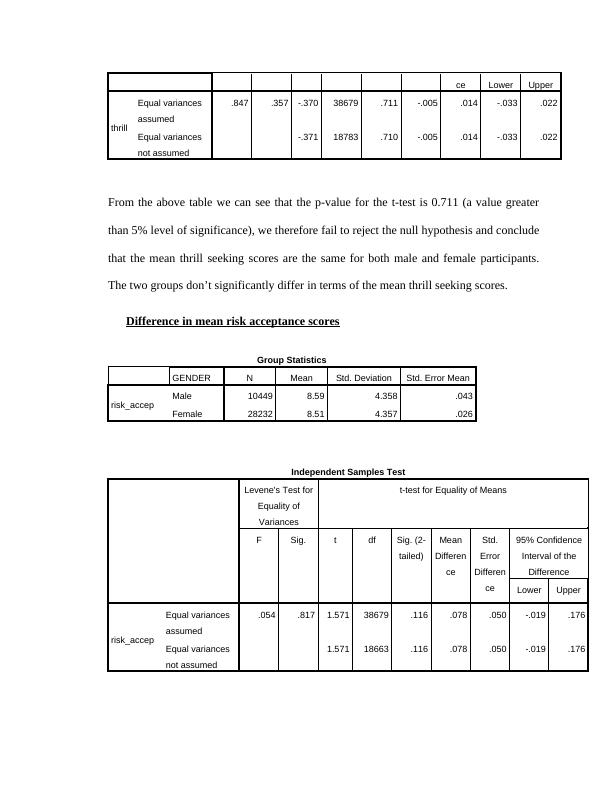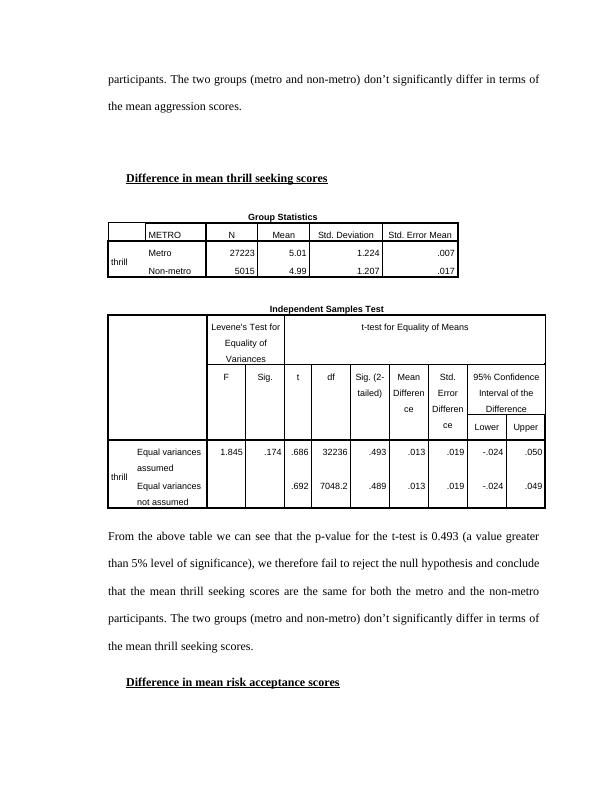Analysis of Dataset in Biostatistics
Added on 2023-01-19
37 Pages7095 Words30 Views
Biostatistics
Student Name:
Instructor Name:
Course Number:
16 April 2019
Student Name:
Instructor Name:
Course Number:
16 April 2019

Assessment Task 1: Analysis of dataset
1. In your SPSS file, age (at time of enrolment) is given as a continuous variable.
a. What is the mean, standard deviation, minimum and maximum values for age?
Answer
Table 1 below presents the descriptive statistics for the variable age. As can be seen, the
mean age of the respondents was 20.50 years old with the oldest participant being 59
years old and the youngest participant being 16 years old. The standard deviation is 4.89.
Table 1: Descriptive Statistics
N Minimum Maximum Mean Std. Deviation
AGE 38681 16 59 20.50 4.888
Valid N (listwise) 38681
b. What is the frequency (% and number) of students in each of these new age
categories?
Answer
In the next table we present the frequency for the newly created variable (age group).
As can be seen, majority (45.9%, n = 17760) are aged 18 years and below while
minority group (9.7%, n = 3755) were aged 26 years and above.
Table 2: Age group
Frequency Percent Valid Percent Cumulative Percent
Valid
18 yrs. Old and below 17760 45.9 45.9 45.9
19 to 21 yrs. old 11672 30.2 30.2 76.1
22 to 25 yrs. old 5494 14.2 14.2 90.3
26 yrs. Old and above 3755 9.7 9.7 100.0
Total 38681 100.0 100.0
2. Descriptive statistics for the demographic information of the students
1. In your SPSS file, age (at time of enrolment) is given as a continuous variable.
a. What is the mean, standard deviation, minimum and maximum values for age?
Answer
Table 1 below presents the descriptive statistics for the variable age. As can be seen, the
mean age of the respondents was 20.50 years old with the oldest participant being 59
years old and the youngest participant being 16 years old. The standard deviation is 4.89.
Table 1: Descriptive Statistics
N Minimum Maximum Mean Std. Deviation
AGE 38681 16 59 20.50 4.888
Valid N (listwise) 38681
b. What is the frequency (% and number) of students in each of these new age
categories?
Answer
In the next table we present the frequency for the newly created variable (age group).
As can be seen, majority (45.9%, n = 17760) are aged 18 years and below while
minority group (9.7%, n = 3755) were aged 26 years and above.
Table 2: Age group
Frequency Percent Valid Percent Cumulative Percent
Valid
18 yrs. Old and below 17760 45.9 45.9 45.9
19 to 21 yrs. old 11672 30.2 30.2 76.1
22 to 25 yrs. old 5494 14.2 14.2 90.3
26 yrs. Old and above 3755 9.7 9.7 100.0
Total 38681 100.0 100.0
2. Descriptive statistics for the demographic information of the students

Answer
Table 3: Demographic characteristics
Demographic characteristics Frequency (n) Percent (%)
State
NSW 15860 41.0
Victoria 13571 35.1
Queensland 7528 19.5
ACT 1722 4.5
Total 38681 100.0
Fees Status
Domestic 32238 83.3
International 6443 16.7
Total 38681 100.0
Cohort
2005 3259 8.4
2006 3615 9.3
2007 3944 10.2
2008 4086 10.6
2009 5010 13.0
2010 5687 14.7
2011 6383 16.5
2012 6697 17.3
Total 38681 100.0
Living Arrangement
At home 20840 53.9
College/student
accommodation
6850 17.7
Independently 10991 28.4
Total 38681 100.0
Age
< 18 yrs. old 17760 45.9
19-21 yrs. old 11672 30.2
22-25 yrs. old 5494 14.2
> 26 yrs. old 3755 9.7
Total 38681 100.0
Metro
Metro 27223 70.4
Table 3: Demographic characteristics
Demographic characteristics Frequency (n) Percent (%)
State
NSW 15860 41.0
Victoria 13571 35.1
Queensland 7528 19.5
ACT 1722 4.5
Total 38681 100.0
Fees Status
Domestic 32238 83.3
International 6443 16.7
Total 38681 100.0
Cohort
2005 3259 8.4
2006 3615 9.3
2007 3944 10.2
2008 4086 10.6
2009 5010 13.0
2010 5687 14.7
2011 6383 16.5
2012 6697 17.3
Total 38681 100.0
Living Arrangement
At home 20840 53.9
College/student
accommodation
6850 17.7
Independently 10991 28.4
Total 38681 100.0
Age
< 18 yrs. old 17760 45.9
19-21 yrs. old 11672 30.2
22-25 yrs. old 5494 14.2
> 26 yrs. old 3755 9.7
Total 38681 100.0
Metro
Metro 27223 70.4

Non-metro 5015 13.0
Missing 6443 16.7
Total 38681 100.0
Degree Type
Single 34620 89.5
Double 4061 10.5
Total 38681 100.0
Faculty
Arts and Sciences 9004 23.3
Education 15038 38.9
Health Sciences 11729 30.3
Theology and Philosophy 588 1.5
Business 2322 6.0
Total 38681 100.0
Study Type
FT 34770 89.9
PT 3911 10.1
Total 38681 100.0
Table 3 above gives the demographic characteristics of the sample under study. Clearly
most of the participants were from NSW state followed by Victoria State. In terms of
cohort, most of the participants were in the cohort of 2012 while the least came from the
cohort of 2005. In terms of age, majority (45.9%, n = 17760) are aged 18 years and below
while minority group (9.7%, n = 3755) were aged 26 years and above.
3. Testing for the difference in means
Answer
a. Gender
Difference in mean aggression scores
Group Statistics
GENDER N Mean Std. Deviation Std. Error Mean
Missing 6443 16.7
Total 38681 100.0
Degree Type
Single 34620 89.5
Double 4061 10.5
Total 38681 100.0
Faculty
Arts and Sciences 9004 23.3
Education 15038 38.9
Health Sciences 11729 30.3
Theology and Philosophy 588 1.5
Business 2322 6.0
Total 38681 100.0
Study Type
FT 34770 89.9
PT 3911 10.1
Total 38681 100.0
Table 3 above gives the demographic characteristics of the sample under study. Clearly
most of the participants were from NSW state followed by Victoria State. In terms of
cohort, most of the participants were in the cohort of 2012 while the least came from the
cohort of 2005. In terms of age, majority (45.9%, n = 17760) are aged 18 years and below
while minority group (9.7%, n = 3755) were aged 26 years and above.
3. Testing for the difference in means
Answer
a. Gender
Difference in mean aggression scores
Group Statistics
GENDER N Mean Std. Deviation Std. Error Mean

driver_agg Male 10449 7.52 4.335 .042
Female 28232 7.51 4.347 .026
Independent Samples Test
Levene's Test for
Equality of
Variances
t-test for Equality of Means
F Sig. t df Sig. (2-
tailed)
Mean
Differen
ce
Std.
Error
Differen
ce
95% Confidence
Interval of the
Difference
Lower Upper
driver_agg
Equal variances
assumed
.117 .732 .083 38679 .934 .004 .050 -.093 .102
Equal variances
not assumed
.083 18713 .934 .004 .050 -.093 .102
From the above table we can see that the p-value for the t-test is 0.934 (a value greater
than 5% level of significance), we therefore fail to reject the null hypothesis and conclude
that the mean aggression scores are the same for both male and female participants. The
two groups don’t significantly differ in terms of the mean aggressions scores.
Difference in mean thrill seeking scores
Group Statistics
GENDER N Mean Std. Deviation Std. Error Mean
thrill Male 10449 5.00 1.217 .012
Female 28232 5.00 1.226 .007
Independent Samples Test
Levene's Test for
Equality of
Variances
t-test for Equality of Means
F Sig. t Df Sig. (2-
tailed)
Mean
Differen
ce
Std.
Error
Differen
95% Confidence
Interval of the
Difference
Female 28232 7.51 4.347 .026
Independent Samples Test
Levene's Test for
Equality of
Variances
t-test for Equality of Means
F Sig. t df Sig. (2-
tailed)
Mean
Differen
ce
Std.
Error
Differen
ce
95% Confidence
Interval of the
Difference
Lower Upper
driver_agg
Equal variances
assumed
.117 .732 .083 38679 .934 .004 .050 -.093 .102
Equal variances
not assumed
.083 18713 .934 .004 .050 -.093 .102
From the above table we can see that the p-value for the t-test is 0.934 (a value greater
than 5% level of significance), we therefore fail to reject the null hypothesis and conclude
that the mean aggression scores are the same for both male and female participants. The
two groups don’t significantly differ in terms of the mean aggressions scores.
Difference in mean thrill seeking scores
Group Statistics
GENDER N Mean Std. Deviation Std. Error Mean
thrill Male 10449 5.00 1.217 .012
Female 28232 5.00 1.226 .007
Independent Samples Test
Levene's Test for
Equality of
Variances
t-test for Equality of Means
F Sig. t Df Sig. (2-
tailed)
Mean
Differen
ce
Std.
Error
Differen
95% Confidence
Interval of the
Difference

ce Lower Upper
thrill
Equal variances
assumed
.847 .357 -.370 38679 .711 -.005 .014 -.033 .022
Equal variances
not assumed
-.371 18783 .710 -.005 .014 -.033 .022
From the above table we can see that the p-value for the t-test is 0.711 (a value greater
than 5% level of significance), we therefore fail to reject the null hypothesis and conclude
that the mean thrill seeking scores are the same for both male and female participants.
The two groups don’t significantly differ in terms of the mean thrill seeking scores.
Difference in mean risk acceptance scores
Group Statistics
GENDER N Mean Std. Deviation Std. Error Mean
risk_accep Male 10449 8.59 4.358 .043
Female 28232 8.51 4.357 .026
Independent Samples Test
Levene's Test for
Equality of
Variances
t-test for Equality of Means
F Sig. t df Sig. (2-
tailed)
Mean
Differen
ce
Std.
Error
Differen
ce
95% Confidence
Interval of the
Difference
Lower Upper
risk_accep
Equal variances
assumed
.054 .817 1.571 38679 .116 .078 .050 -.019 .176
Equal variances
not assumed
1.571 18663 .116 .078 .050 -.019 .176
thrill
Equal variances
assumed
.847 .357 -.370 38679 .711 -.005 .014 -.033 .022
Equal variances
not assumed
-.371 18783 .710 -.005 .014 -.033 .022
From the above table we can see that the p-value for the t-test is 0.711 (a value greater
than 5% level of significance), we therefore fail to reject the null hypothesis and conclude
that the mean thrill seeking scores are the same for both male and female participants.
The two groups don’t significantly differ in terms of the mean thrill seeking scores.
Difference in mean risk acceptance scores
Group Statistics
GENDER N Mean Std. Deviation Std. Error Mean
risk_accep Male 10449 8.59 4.358 .043
Female 28232 8.51 4.357 .026
Independent Samples Test
Levene's Test for
Equality of
Variances
t-test for Equality of Means
F Sig. t df Sig. (2-
tailed)
Mean
Differen
ce
Std.
Error
Differen
ce
95% Confidence
Interval of the
Difference
Lower Upper
risk_accep
Equal variances
assumed
.054 .817 1.571 38679 .116 .078 .050 -.019 .176
Equal variances
not assumed
1.571 18663 .116 .078 .050 -.019 .176

From the above table we can see that the p-value for the t-test is 0.116 (a value greater
than 5% level of significance), we therefore fail to reject the null hypothesis and conclude
that the mean risk acceptance scores are the same for both male and female participants.
The two groups (males and females) don’t significantly differ in terms of the mean risk
acceptance scores.
b. Metropolitan background status
Difference in mean aggression scores
Group Statistics
METRO N Mean Std. Deviation Std. Error Mean
driver_agg Metro 27223 7.53 4.345 .026
Non-metro 5015 7.49 4.303 .061
Independent Samples Test
Levene's Test for
Equality of
Variances
t-test for Equality of Means
F Sig. t df Sig. (2-
tailed)
Mean
Differen
ce
Std.
Error
Differen
ce
95% Confidence
Interval of the
Difference
Lower Upper
driver_agg
Equal variances
assumed
1.060 .303 .714 32236 .475 .048 .067 -.083 .178
Equal variances
not assumed
.719 7029 .472 .048 .066 -.082 .177
From the above table we can see that the p-value for the t-test is 0.475 (a value greater
than 5% level of significance), we therefore fail to reject the null hypothesis and conclude
that the mean aggression scores are the same for both the metro and the non-metro
than 5% level of significance), we therefore fail to reject the null hypothesis and conclude
that the mean risk acceptance scores are the same for both male and female participants.
The two groups (males and females) don’t significantly differ in terms of the mean risk
acceptance scores.
b. Metropolitan background status
Difference in mean aggression scores
Group Statistics
METRO N Mean Std. Deviation Std. Error Mean
driver_agg Metro 27223 7.53 4.345 .026
Non-metro 5015 7.49 4.303 .061
Independent Samples Test
Levene's Test for
Equality of
Variances
t-test for Equality of Means
F Sig. t df Sig. (2-
tailed)
Mean
Differen
ce
Std.
Error
Differen
ce
95% Confidence
Interval of the
Difference
Lower Upper
driver_agg
Equal variances
assumed
1.060 .303 .714 32236 .475 .048 .067 -.083 .178
Equal variances
not assumed
.719 7029 .472 .048 .066 -.082 .177
From the above table we can see that the p-value for the t-test is 0.475 (a value greater
than 5% level of significance), we therefore fail to reject the null hypothesis and conclude
that the mean aggression scores are the same for both the metro and the non-metro

participants. The two groups (metro and non-metro) don’t significantly differ in terms of
the mean aggression scores.
Difference in mean thrill seeking scores
Group Statistics
METRO N Mean Std. Deviation Std. Error Mean
thrill Metro 27223 5.01 1.224 .007
Non-metro 5015 4.99 1.207 .017
Independent Samples Test
Levene's Test for
Equality of
Variances
t-test for Equality of Means
F Sig. t df Sig. (2-
tailed)
Mean
Differen
ce
Std.
Error
Differen
ce
95% Confidence
Interval of the
Difference
Lower Upper
thrill
Equal variances
assumed
1.845 .174 .686 32236 .493 .013 .019 -.024 .050
Equal variances
not assumed
.692 7048.2 .489 .013 .019 -.024 .049
From the above table we can see that the p-value for the t-test is 0.493 (a value greater
than 5% level of significance), we therefore fail to reject the null hypothesis and conclude
that the mean thrill seeking scores are the same for both the metro and the non-metro
participants. The two groups (metro and non-metro) don’t significantly differ in terms of
the mean thrill seeking scores.
Difference in mean risk acceptance scores
the mean aggression scores.
Difference in mean thrill seeking scores
Group Statistics
METRO N Mean Std. Deviation Std. Error Mean
thrill Metro 27223 5.01 1.224 .007
Non-metro 5015 4.99 1.207 .017
Independent Samples Test
Levene's Test for
Equality of
Variances
t-test for Equality of Means
F Sig. t df Sig. (2-
tailed)
Mean
Differen
ce
Std.
Error
Differen
ce
95% Confidence
Interval of the
Difference
Lower Upper
thrill
Equal variances
assumed
1.845 .174 .686 32236 .493 .013 .019 -.024 .050
Equal variances
not assumed
.692 7048.2 .489 .013 .019 -.024 .049
From the above table we can see that the p-value for the t-test is 0.493 (a value greater
than 5% level of significance), we therefore fail to reject the null hypothesis and conclude
that the mean thrill seeking scores are the same for both the metro and the non-metro
participants. The two groups (metro and non-metro) don’t significantly differ in terms of
the mean thrill seeking scores.
Difference in mean risk acceptance scores

End of preview
Want to access all the pages? Upload your documents or become a member.
Related Documents
Analysis of Dataset in Biostatisticslg...
|23
|4406
|97
Difference in Mean Aggression, Thrill Seeking, and Risk Accepting between Genders, Metropolitan Backgrounds, and Study Modeslg...
|16
|2947
|51
Difference in Mean Aggression, Thrill Seeking, and Risk Accepting between Genders, Metropolitan Backgrounds, and Study Modeslg...
|16
|2232
|87
Difference in Mean Aggression, Thrill Seeking, and Risk Accepting between Genders, Metropolitan Backgrounds, and Study Modeslg...
|15
|2774
|55
Test for Difference in Mean Aggression, Thrill Seeking, and Risk Acceptinglg...
|19
|3679
|60
Data Analysis: Descriptive Statistics and Tests for Mean Differenceslg...
|15
|2791
|155